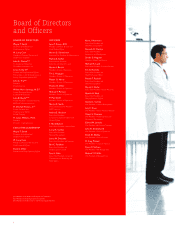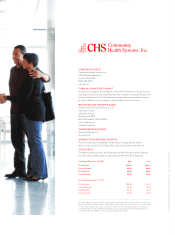Community Health Systems 2015 Annual Report Download - page 17
Download and view the complete annual report
Please find page 17 of the 2015 Community Health Systems annual report below. You can navigate through the pages in the report by either clicking on the pages listed below, or by using the keyword search tool below to find specific information within the annual report.including orthopedics, neuroscience, cardiovascular care, women’s health and cancer care. The expansion of
these service lines has also been enabled through providing additional access points separate from the traditional
hospital service location, through the maximization of physician practice utilization, partnerships with third-party
urgent care and retail service locations, expansion of outside diagnostic and surgery center locations, and
advancing tele-health strategies.
We spent approximately $451 million on 70 major construction projects that were completed in 2015. The
2015 projects included new emergency rooms, cardiac catheterization laboratories, hospital additions and
surgical suites. These projects improved various diagnostic and other inpatient and outpatient service capabilities.
We believe that appropriate capital investments in our facilities, combined with the development of our service
capabilities, will reduce the migration of patients to competing providers while providing an attractive return on
investment. We also employ a small group of clinical consultants at our corporate headquarters to assist the
hospitals in their development of surgery, emergency, critical care, cardiovascular and hospitalist services. In
addition to spending capital on expanding services at our existing hospitals, we also build replacement facilities
in certain markets to better meet the healthcare needs in those communities. In 2015 and 2014, we spent $123
million and $120 million, respectively, on construction projects related to the Birmingham and York replacement
hospitals discussed below. In September 2010, we received approval of our request for a certificate of need, or
CON, from the Alabama Certificate of Need Review Board for a replacement hospital in Birmingham, Alabama.
This CON was challenged in the Alabama state circuit and appellate courts, but the CON was upheld by the
Supreme Court of Alabama in May 2013, eliminating any further appeals. Completion of the replacement
hospital, Grandview Medical Center, and transfer of all operations was completed on October 10, 2015. As part
of an acquisition in 2012, we agreed to build a replacement hospital in York, Pennsylvania by July 2017. The
total cost of the replacement hospital in York, Pennsylvania is estimated to be $125 million.
Managed Care Strategy. Managed care has seen growth across the U.S. as health plans expand service areas
and membership in an attempt to control rising medical costs. As we service primarily non-urban markets, we do
not have significant relationships with individual managed care organizations, including Medicare Advantage.
We have responded with a proactive and carefully considered strategy developed specifically for each of our
facilities. Our experienced corporate managed care department reviews and approves all managed care contracts,
which are organized and monitored using a central database. The primary mission of this department is to select
and evaluate appropriate managed care opportunities, manage existing reimbursement arrangements and
negotiate increases. Generally, we do not intend to enter into capitated or risk sharing contracts. However, some
purchased hospitals have risk sharing contracts at the time we acquire them. We seek to discontinue these
contracts to eliminate risk retention related to payment for patient care. We do not believe that we have, at the
present time, any risk sharing contracts that would have a material impact on our results of operations.
Improve Profitability
Overview. To improve efficiencies and increase operating margins, we implement cost containment programs
and adhere to operating philosophies that include:
• standardizing and centralizing our methods of operation and management, including:
• monitoring and enhancing productivity of our human resources,
• capitalizing on purchasing efficiencies through the use of company-wide standardized purchasing
contracts and terminating or renegotiating specified vendor contracts,
• installing standardized management information systems, resulting in more streamlined clinical
operations and more efficient billing and collection procedures, and
• improving patient safety and optimizing resource allocation through our case and resource management
program, which assists in improving clinical care and containing costs.
4
























